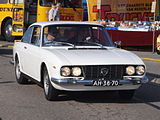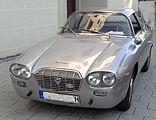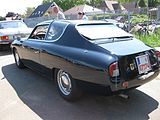Lancia Flavia
| Lancia | |
|---|---|
|
Lancia Flavia Berlina (1960-1967)
|
|
| Flavia | |
| Production period: | 1960-1970 |
| Class : | upper middle class |
| Body versions : | Sedan , coupe , convertible |
| Engines: |
Petrol engines : 1.5–2.0 liters (57–92 kW) |
| Length: | 4600 mm |
| Width: | 1610 mm |
| Height: | 1500 mm |
| Wheelbase : | 2600 mm |
| Empty weight : | 1210 kg |
| successor | Lancia 2000 |
The Lancia Flavia is an upper middle class vehicle that was built by the manufacturer Lancia between the autumn of 1960 and the end of 1970.
The Flavia was the first Italian production car with front-wheel drive and disc brakes on all four wheels. The vehicle developed under Antonio Fessia had a dual-circuit braking system and was powered by a light metal boxer engine placed in front of the front axle.
For the manufacturer, the Flavia represented a turning point in the company's history for several reasons: It was the first vehicle to usher in the tradition of front-wheel drive at Lancia, which continued until 2011. For the first time, Lancia used a boxer engine and thus since 1919 again an engine in a car in which the cylinders were not arranged in a V-shape. At the same time, the Flavia, together with the Fulvia, was the last passenger car that Lancia developed completely independently and before the takeover by Fiat.
The design language of the sedan was already considered conservative at the time of construction, so that the vehicle was only sold in large numbers with the 1.8-liter engine and the 1800 Iniezione injection variant . Shortly before the end of the series, a 2.0 l machine followed as a carburettor and injection version 2000 Iniezione .
Flavia Berlina (limousine)
As the first model of the Flavia series, the sedan ( Berlina ) was presented at the Turin Motor Show in November 1960 . The then technical director of Lancia, Dr.-Ing. Antonio Fessia , was a proponent of front-wheel drive and the boxer engine. This was reflected in the technical implementation of the Flavia. Fessia had already implemented and anticipated the basic design features of the Flavia in the CEMSA Caproni CEMSA F11, which was shown at the Paris Motor Show in 1947, but it was never mass-produced.
First series (1960–1967)
The first series of the Flavia sedan (type 815) was equipped with a continuous bench seat and steering wheel gearshift at the front. The front wheels of the Flavia were independently suspended from double wishbones and sprung with a leaf spring above the gearbox. The front suspension was attached to a subframe , which also carried the engine-transmission unit. The rear wheels were connected to the body by a rigid tubular steel axle, an axle strut and two longitudinal leaf springs hinged with silent blocks. All wheels had hydraulic telescopic shock absorbers, and both axles were equipped with anti-roll bars. The wheels were driven by drive shafts with two constant velocity joints each. Equipped with the original 1500 engine, the Flavia was initially considered to be underpowered for a car in its price range. Although it had an output of at least 57 kW (78 hp), this was the result of excellent engine characteristics with low elasticity . In addition, the power-to-weight ratio of the 1260 kg car was unfavorable. Only the 1800 cc engine, which was offered as an option from 1963, only helped.
Second series (1967–1970)
With the introduction of the second series in May 1967 (type 819), the body of the Flavia sedan was completely redesigned and given a different interior. Instead of the bench, two front individual seats were installed and the steering wheel gearshift was replaced by a central gearshift. The new body made it possible to slightly increase the top speed, which was now 165 km / h for the carburettor version and 170 km / h for the injector.
From the beginning of 1969, the 2.0-liter engine was added to the range as the highest engine size. The aggregate made as a gasifier 115 and PS as injector Iniezione 125 hp. They reached a top speed of 175 and 180 km / h.
The Flavia limousine served as the technical basis for all other model variants of the Flavia presented later. Production of the sedan ended at the end of 1970.
Flavia Coupe
Based on the sedan, but with a wheelbase shortened to 2,480 cm, the Flavia Coupé appeared in spring 1962.
Pininfarina was responsible for the design and production of the body . The coupé had a two-door notchback body, offered four seats and weighed around 200 kg less than the sedan.
At the beginning of 1969 the coupe was revised. It received a modified front and a slightly modified rear. In addition, the displacement of the 1.5 and 1.8 liter engines has been increased slightly. With the otherwise optical facelift, the 2.0-liter engine was also used as a carburetor and injector, the values of which corresponded to those of the sedan. Here the maximum speed of the injector was 185 km / h.
Production of the coupé ceased at the end of 1970.
Flavia Sport
From June 1962 to May 1967 a second coupé variant was offered, the Lancia Flavia Sport. She is known colloquially today as Flavia Zagato .
The Flavia Sport was designed and manufactured by Zagato and was primarily developed for racing.
In addition to the trunk lid, the Sport has a rear window that can be opened a few centimeters from the inside at the push of a button. The outer skin of the body is made entirely of aluminum.
Flavia Cabriolet
An open version was also available from June 1962 under the official German sales name Flavia Cabriolet (Italy: Convertibile).
The vehicle designed by Michelotti and built by Vignale was produced until May 1967 and, like the Flavia Coupé, offered four seats.
Engines
| model | year | engine | Displacement | PS | Fuel system |
|---|---|---|---|---|---|
| Berlina | 1960–1962 | Four - cylinder boxer engine , OHV | 1500 cc | 78 hp | Carburetor |
| Coupé, convertible, sport | 1962-1963 | Four-cylinder boxer engine, OHV | 1500 cc | 90 hp | Double carburetor |
| 1500 | 1963-1968 | Four-cylinder boxer engine, OHV | 1488 cc | 76 hp | Carburetor |
| 1800 | 1963-1968 | Four-cylinder boxer engine, OHV | 1800 cc | 92 hp | Carburetor |
| 1800 sports | 1963-1967 | Four-cylinder boxer engine, OHV | 1800 cc | 105 hp | Double carburetor |
| 1800 Iniezione | 1965-1968 | Four-cylinder boxer engine, OHV | 1800 cc | 102 hp | Injector |
| 1500 | 1969-1970 | Four-cylinder boxer engine, OHV | 1490 cc | 80 hp | Carburetor |
| 1800 | 1969-1970 | Four-cylinder boxer engine, OHV | 1816 cc | 92 hp | Carburetor |
| 2000 | 1969-1970 | Four-cylinder boxer engine, OHV | 1991 cc | 115 hp | Carburetor |
| 2000 Iniezione | 1969-1970 | Four-cylinder boxer engine, OHV | 1991 cc | 125 hp | Injector |
The 1800 Iniezione was equipped very early on with a mechanical Kugelfischer injection system, which was widespread in motorsport at the time, but also in sporty series automobiles such as the Peugeot 404 Injection , the BMW 2002 tii , the BMW M1 , the Ford Capri 2600 RS or the Peugeot 504 TI was used.
successor
41,114 copies were sold between the autumn of 1960 and the end of 1970. The successor to the sedan and coupé was the Lancia 2000 .
After the merger of Chrysler and Fiat in 2009, some Chrysler models were sold in Europe under the Lancia brand name. In this context, the Chrysler 200 - in the USA consisting of a four-door notchback sedan and a convertible - was offered in Europe as a convertible with a soft top from mid-2012 to autumn 2014 as the Lancia Flavia .
Web links
- Lancia at Cars from Italy
| Timeline of Lancia and Autobianchi models since 1945 | ||||||||||||||||||||||||||||||||||||||||||||||||||||||||||||||||||||||||||||
|---|---|---|---|---|---|---|---|---|---|---|---|---|---|---|---|---|---|---|---|---|---|---|---|---|---|---|---|---|---|---|---|---|---|---|---|---|---|---|---|---|---|---|---|---|---|---|---|---|---|---|---|---|---|---|---|---|---|---|---|---|---|---|---|---|---|---|---|---|---|---|---|---|---|---|---|---|
| Type | Lancia, independent until 1969 | Purchased by Fiat in 1969, Fiat number range since then | ||||||||||||||||||||||||||||||||||||||||||||||||||||||||||||||||||||||||||
| Autobianchi, JV between Bianchi, Fiat and Pirelli | from 1967 100% part of the Fiat group | abroad as Lancia, in Italy as Autobianchi | ||||||||||||||||||||||||||||||||||||||||||||||||||||||||||||||||||||||||||
| 1940s | 1950s | 1960s | 1970s | 1980s | 1990s | 2000s | 2010s | 2020s | ||||||||||||||||||||||||||||||||||||||||||||||||||||||||||||||||||||
| 5 | 6th | 7th | 8th | 9 | 0 | 1 | 2 | 3 | 4th | 5 | 6th | 7th | 8th | 9 | 0 | 1 | 2 | 3 | 4th | 5 | 6th | 7th | 8th | 9 | 0 | 1 | 2 | 3 | 4th | 5 | 6th | 7th | 8th | 9 | 0 | 1 | 2 | 3 | 4th | 5 | 6th | 7th | 8th | 9 | 0 | 1 | 2 | 3 | 4th | 5 | 6th | 7th | 8th | 9 | 0 | 1 | 2 | 3 | 4th | 5 | 6th | 7th | 8th | 9 | 0 | 1 | 2 | 3 | 4th | 5 | 6th | 7th | 8th | 9 | 0 | |
| Microcar | Bianchina | Giardiniera | ||||||||||||||||||||||||||||||||||||||||||||||||||||||||||||||||||||||||||
| Small car | A112 | Y10 (156) | Y (840) | Ypsilon (843) | Ypsilon (846) | |||||||||||||||||||||||||||||||||||||||||||||||||||||||||||||||||||||||
| Compact class | A111 | Delta I [2] (831) | Delta II (836) | Delta III (844) | ||||||||||||||||||||||||||||||||||||||||||||||||||||||||||||||||||||||||
| Middle class | Primula | Prism (831) | Dedra (835) | Lybra (839) | ||||||||||||||||||||||||||||||||||||||||||||||||||||||||||||||||||||||||
| ... Ardea | Appia | Fulvia | Beta / Trevi (828) | Flavia | ||||||||||||||||||||||||||||||||||||||||||||||||||||||||||||||||||||||||
| upper middle class | Flavia | 2000 | Gamma (830) | Theme (834 / Y9) | Kappa (838) | Thesis (841) | theme | |||||||||||||||||||||||||||||||||||||||||||||||||||||||||||||||||||||
| Coupé / convertible | Stellina | |||||||||||||||||||||||||||||||||||||||||||||||||||||||||||||||||||||||||||
| Fulvia Coupé / Sport | Beta Coupé [1] / Spider / Montecarlo (828) | |||||||||||||||||||||||||||||||||||||||||||||||||||||||||||||||||||||||||||
| Aurelia | Flaminia | Gamma Coupé / GT (830) |
Kappa Coupé (838) |
|||||||||||||||||||||||||||||||||||||||||||||||||||||||||||||||||||||||||
| Sports car | Stratos | |||||||||||||||||||||||||||||||||||||||||||||||||||||||||||||||||||||||||||
| Minivan | Musa (350) | |||||||||||||||||||||||||||||||||||||||||||||||||||||||||||||||||||||||||||
| Van | Zeta (220) | Phedra (179) | Voyager | |||||||||||||||||||||||||||||||||||||||||||||||||||||||||||||||||||||||||
|
[1] also built by Seat in Spain |
||||||||||||||||||||||||||||||||||||||||||||||||||||||||||||||||||||||||||||
literature
- Lancia - Innovation and Fascination: 100 Moving Years (2006), pp. 60–71, Heel Verlag, ISBN 978-3-89880-649-7
Individual evidence
- ↑ Lancia - Progress from Tradition, Editoriale Domus, p. 105
- ↑ Lancia - Progress from Tradition, Editoriale Domus, p. 104
- ↑ Lancia - Progress from Tradition, Editoriale Domus, p. 103
- ↑ Lancia - Progress from Tradition, Editoriale Domus, p. 103
- ↑ Lancia - Progress from Tradition, Editoriale Domus, p. 103
- ↑ Lancia - Progress from Tradition, Editoriale Domus, p. 105
- ^ Ferruccio Bernabò, continuation of the "History of Lancia" from 1957 to 1969, p. 52 - Servizio Stampa Lancia - N.88795667 - 12/74
- ^ Ferruccio Bernabò, continuation of the "History of the Lancia" from 1957 to 1969, p. 53 - Servizio Stampa Lancia - N.88795667 - 12/74
- ^ Ferruccio Bernabò, continuation of the "History of the Lancia" from 1957 to 1969, p. 53 - Servizio Stampa Lancia - N.88795667 - 12/74
- ↑ Lancia - Progress from Tradition, Editoriale Domus, p. 103
- ↑ Flavia of Lancia . In: Motor vehicle technology 08/1961, pp. 335–336.
- ↑ Lancia - Progress from Tradition, Editoriale Domus, p. 105
- ^ Ferruccio Bernabò, continuation of the "History of the Lancia" from 1957 to 1969, p. 53 - Servizio Stampa Lancia - N.88795667 - 12/74
- ^ Ferruccio Bernabò, continuation of the "History of the Lancia" from 1957 to 1969, p. 53 - Servizio Stampa Lancia - N.88795667 - 12/74
- ^ Ferruccio Bernabò, continuation of the "History of the Lancia" from 1957 to 1969, p. 53 - Servizio Stampa Lancia - N.88795667 - 12/74
- ^ Ferruccio Bernabò, continuation of the "History of the Lancia" from 1957 to 1969, p. 53 - Servizio Stampa Lancia - N.88795667 - 12/74
- ^ Ferruccio Bernabò, continuation of the "History of the Lancia" from 1957 to 1969, p. 53 - Servizio Stampa Lancia - N.88795667 - 12/74
- ↑ Sales brochure Lancia Sport 1.8 - Servizio Stampa Lancia - N.8799132 - 9/63
- ↑ Lancia - Progress from Tradition, Editoriale Domus, p. 107
- ↑ http://www.lanciaflavia.it/varie/model_index.php












